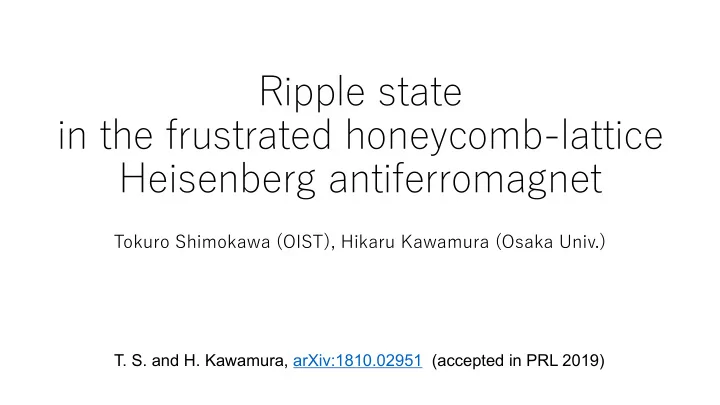

Ripple state in the frustrated honeycomb-lattice Heisenberg antiferromagnet Tokuro Shimokawa (OIST), Hikaru Kawamura (Osaka Univ.) T. S. and H. Kawamura, arXiv:1810.02951 (accepted in PRL 2019)
Introduction Multiple- q states organizing complex magnetic structures are exotic states of matter in magnetic solids. Triple- q skyrmion-lattice state Chiral magnet MnSi Antisymmetric interaction plays important roles for stabilizing the skyrmion-lattice state S. Mühlbauer, et al, Science 323 , 915 (2009). Image by Lorentz transmission N. Nagaosa and Y. Tokura, Nat. Nano. 8 , 899-911 (2013). electron microscopy
Introduction J 1 - J 3 classical triangular-lattice Heisenberg model Snapshot of spin and chirality config. T. Okubo, S. Chung, and H. Kawamura, PRL 108 , 017206 (2012). in the triple- q state and Z state Spin structure factors MC phase diagram ・Skyrmion state can appear without the DM interaction. ・Anti-Skyrmion state can also appear. ・A mixed state of skyrmion and antiskyrmion domains appears.
Purpose, model and method in our study Search for more exotic frustration-induced multiple- q states! J 1 - J 2 classical honeycomb-lattice Heisenberg model Monte Carlo (MC) simulation J 1 Heat-bath, over-relaxation, temperature-exchange methods Open/Periodic boundary conditions J 2 Maximum system size N =115200 ( L =240) We mainly focus the J 2 / J 1 =0.18 case under magnetic fields at moderate temperature. For other J 2 / J 1 cases T. S., T. Okubo and H. Kawamura, arXiv:1902.01582
Ring-like degeneracy J 1 - J 2 classical honeycomb-lattice Heisenberg model Ground state phase diagram under H =0 J 1 J 2 S. Katsura, et al ., J. Stat. Phys. 42 , 381 (1986). Ring-like degeneracy
Ring-like degeneracy could be a source for exotic states Finite-temperature phase diagram under H =0 Sublattice static spin structure factors in each state Ring Para liquid Ring-degeneracy in J 2 / J 1 =0.18 Single- q Pancake Single- q liquid S. Okumura, et al ., JPSJ 79 , 114705 (2010).
T - H phase diagram at J 2 / J 1 =0.18 Para.
Single- q , ring-liquid, pancake-liquid states Single- q (INT) Ring-liquid Pancake-liquid
Ripple state under open B.C. Ripple state (open B.C.) Single- q (INT) Ring-liquid Spiral is running along every direction from a core Ring-like pattern still remains in the static spin structure factor
Phase transition between ring-liquid and ripple states Ripple Ring-liquid Sublattice spin texture Sublattice local scalar chirality Definition of the sublattice local scalar chirality Z 2 symmetry is broken spontaneously in the ripple state. S i ・( S j × S k )
Ripple state under periodic B.C. Sublattice xy spin texture in the ripple state ( L =180, periodic) L =240, periodic Antivortex Vortex The ripple state does not form a crystal although the translational symmetry is broken in algebraic manner. Incompatibility against the periodic B.C. produces an interference effect and vortex/antivortex textures.
Candidate material? S =3/2 bilayer honeycomb-lattice antiferromagnet Quantum spin liquid candidate Magnetization curve Field-induced phase transition accompanied with AF LRO in the xy plane O. Smirnova et al , JACS 131 , 8313 (2009). M. Matsuda et al , PRL 105 , 187201 (2010). Interlayer coupling is not negligible..., but the nature of its ordering might be understandable within a single-layer honeycomb-lattice classical Heisenberg model. S. Okumura, et al ., JPSJ 79 , 114705 (2010).
Field-induced AF region AF SRO is enhanced by the field in our theoretical model (by Okumura et al ) Ripple state might appear in the single crystal of the Bi 3 Mn 4 O 12 (NO 3 )?
Ripple state can induce a giant-electric polarization vortex Ripple state Polarization texture Single- q Spin A. K. Yadev, et al, Nature 530 , 198 (2016). H. Katsura, et al, PRL 95 , 057205 (2005).
Summary We have found a new type of multiple- q state, ripple state, in the J 1 - J 2 classical honeycomb-lattice Heisenberg antiferromagnet, discussing its possible realization in S =3/2 honeycomb-lattice antiferromagnet Bi 3 Mn 4 O 12 (NO 3 ). Ripple Ring T. S. and H. Kawamura, arXiv:1810.02951 (Related work is, T. S., T. Okubo and H. Kawamura, arXiv:1902.01582)
Recommend
More recommend